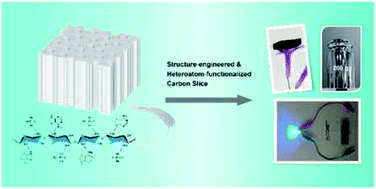Nature-derived, structure and function integrated ultra-thick carbon electrode for high-performance supercapacitors†
Abstract
The design of ultra-thick electrodes for energy storage has the potential to significantly increase the device-level energy density, but still faces major challenges of low mechanical stability and slow charge kinetics. Herein, inspired by the hierarchical structure and lignocellulosic component of natural wood, we developed a structure-engineered and heteroatom-functionalized carbon slice, leveraging selective delignification and hydrogen bonding chemistry via pyrolyzing the as-modified porous cellulose following a one-pot chemical treatment of natural wood. When explored as a binder-free, conductive-additive-free, and self-supporting ultra-thick electrode, the electrode shows outstanding areal and gravimetric capacitance of 2980 mF cm−2 and 183 F g−1, respectively. Moreover, the as-assembled quasi-solid-state symmetric supercapacitor yields high areal, gravimetric and volumetric energy densities of 0.3 mW h cm−2, 9.68 W h kg−1, and 0.63 mW h cm−3, respectively. The excellent electrochemical properties can be attributed to the synergistic effect of dual heteroatom-containing groups and well-aligned channels. This work provides a new design strategy for ultra-thick electrodes toward next-generation, high-performance energy storage devices.



 Please wait while we load your content...
Please wait while we load your content...